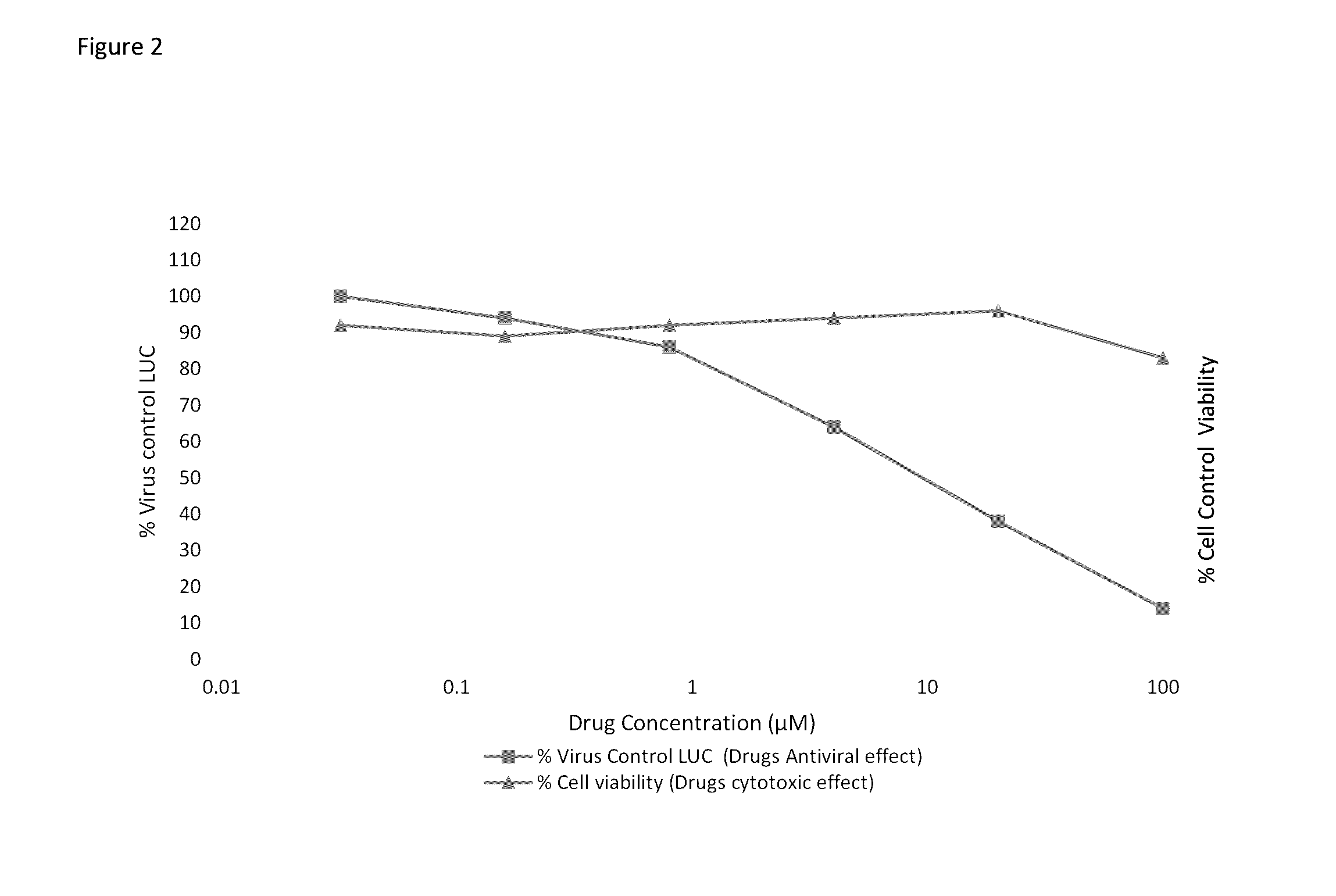Thienopyridine derivative for the treatment of hepatitis c infections
a technology of thienopyridine and hepatitis c, which is applied in the field of hepatitis c treatment methods, can solve the problems of limited treatment efficacy, hcv continues to be a major cause of concern, and a huge burden on the public health system worldwide,
- Summary
- Abstract
- Description
- Claims
- Application Information
AI Technical Summary
Benefits of technology
Problems solved by technology
Method used
Image
Examples
example 1
[0042]Stable HCV replicons of different genotypes may be used for anti-HCV evaluation. We use the subgenomic HCV replicons of genotype 1a (H77 strain), 1b (Con1 strain), and 2a (JFH-1 strain), which are Huh7 human hepatoma cell lines that contains an HCV replicon.
[0043]The HCV replicon antiviral evaluation assay examines the effects of compound at six serial dilutions. Human interferon alpha-2b (rIFNα-2b) and Sofosbuvir are included in each run as a positive control compound.
[0044]Briefly, the replicon cells are plated at 5,000 cells / well into 96-well plates that are dedicated for the analysis of cell numbers (cytotoxicity) or antiviral activity. On the following day, samples are diluted with assay media and added to the appropriate wells. Cells are processed 72 hours later when the cells are still sub-confluent. For the luciferase endpoint assay, HCV replicon levels are assessed as replicon-derived Luc activity. The concentration of drug that reduces cell viabilit...
example 2
Infectious HCVcc Assay
[0045]Huh7.5 cells are grown in Dulbecco's modified essential media (DMEM), 10% fetal bovine serum (FBS), 1% penicillin-streptomycin (pen-strep), 1% Non-essential amino acids (NEAA) in a 5% CO2 incubator at 37° C. Huh7.5 cells are seeded at 1×104 cells per well into 96-well plates according to Southern Research Institute standard format. Test articles are serially diluted with DMEM plus 5% FBS. The diluted compound in the amount of 50 μl is mixed with equal volume of cell culture-derived HCV (HCVcc), then applied to appropriate wells in the plate. Human interferon alpha-2b (rIFNα-2b) and / or Sofosbuvir are included as a positive control. After 72 hr incubation at 37° C., the cells are lysed for measurement of luciferase activity using Renilla Luciferase Assay System (Promega) according to manufacturer's instruction. The number of cells in each well is determined by CytoTox-1 reagent (Promega). Test articles are tested at 6 serial dilutions in triplicate to deriv...
example 3
Dosage Forms
[0046]
Dosage Form AQty / Unit (mg)Sr. No.Ingredients5.0 mg10.0 mgStrength1.Prasugrel5.0010.002.Mannitol45.0090.003.Microcrystalline Cellulose61.00122.004.Hypromellose30.0060.05.Croscarmellose Sodium7.5015.006.Magnesium stearate1.503.00Coating7.Opadry II White6.0012.00
Process:
[0047]1. Prasugrel and Mannitol, Microcrystalline cellulose, Hypromellose, Croscarmellose sodium was co-sifted through suitable mesh sieve.[0048]2. Pre-sifted ingredients obtained in Step1 were loaded in Saizoner or Rapid mixer granulator and granulated using suitable solvent.[0049]3. The granules obtained in step 2 were dried and sized through Co-mill using suitable Screen and sieve size.[0050]4. The dried and sized granules obtained in step 3 were lubricated with pre-sifted magnesium stearate in a suitable blender.[0051]5. The lubricated granules obtained in step 4 were compressed Coating solution was prepared by dissolving the Opadry II white in Purified water and the compressed tablets obtained in ...
PUM
| Property | Measurement | Unit |
|---|---|---|
| particle size | aaaaa | aaaaa |
| particle size | aaaaa | aaaaa |
| particle size | aaaaa | aaaaa |
Abstract
Description
Claims
Application Information
 Login to View More
Login to View More - R&D
- Intellectual Property
- Life Sciences
- Materials
- Tech Scout
- Unparalleled Data Quality
- Higher Quality Content
- 60% Fewer Hallucinations
Browse by: Latest US Patents, China's latest patents, Technical Efficacy Thesaurus, Application Domain, Technology Topic, Popular Technical Reports.
© 2025 PatSnap. All rights reserved.Legal|Privacy policy|Modern Slavery Act Transparency Statement|Sitemap|About US| Contact US: help@patsnap.com



